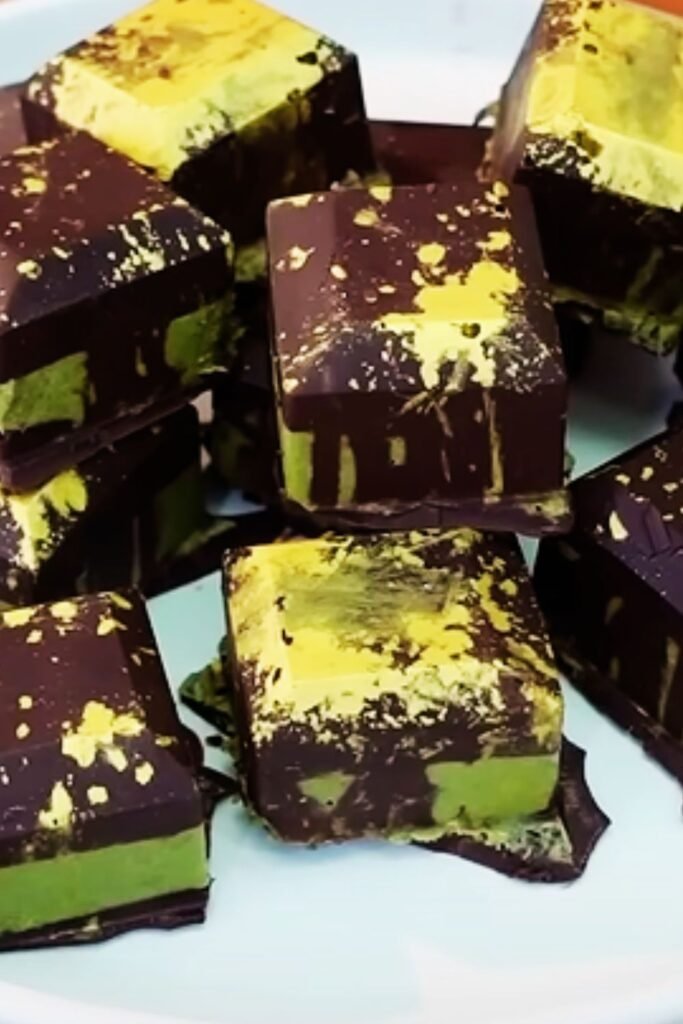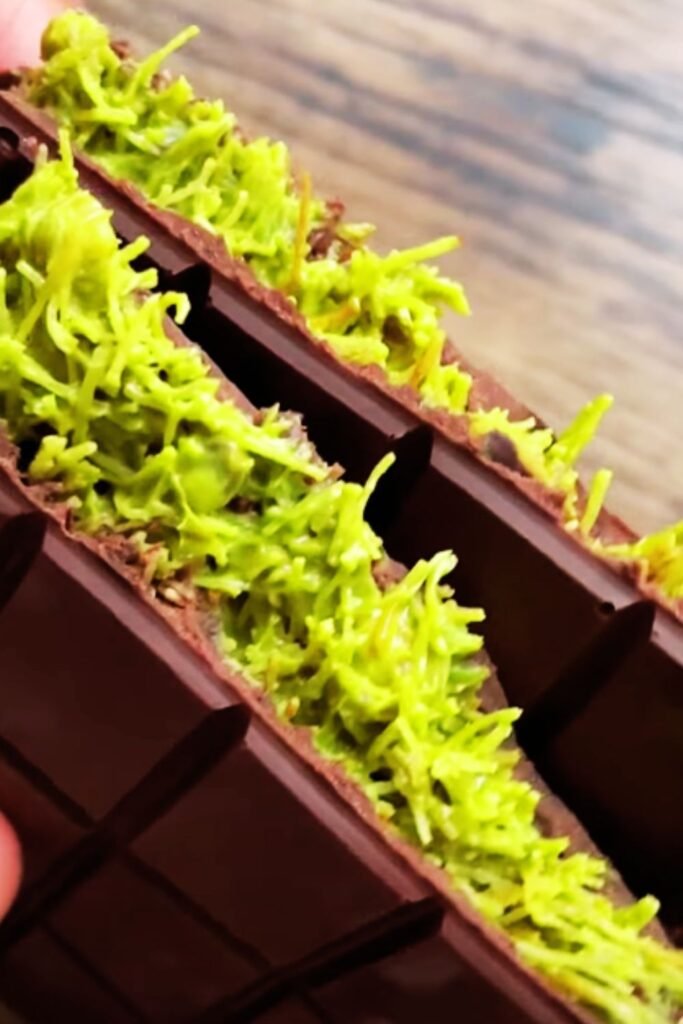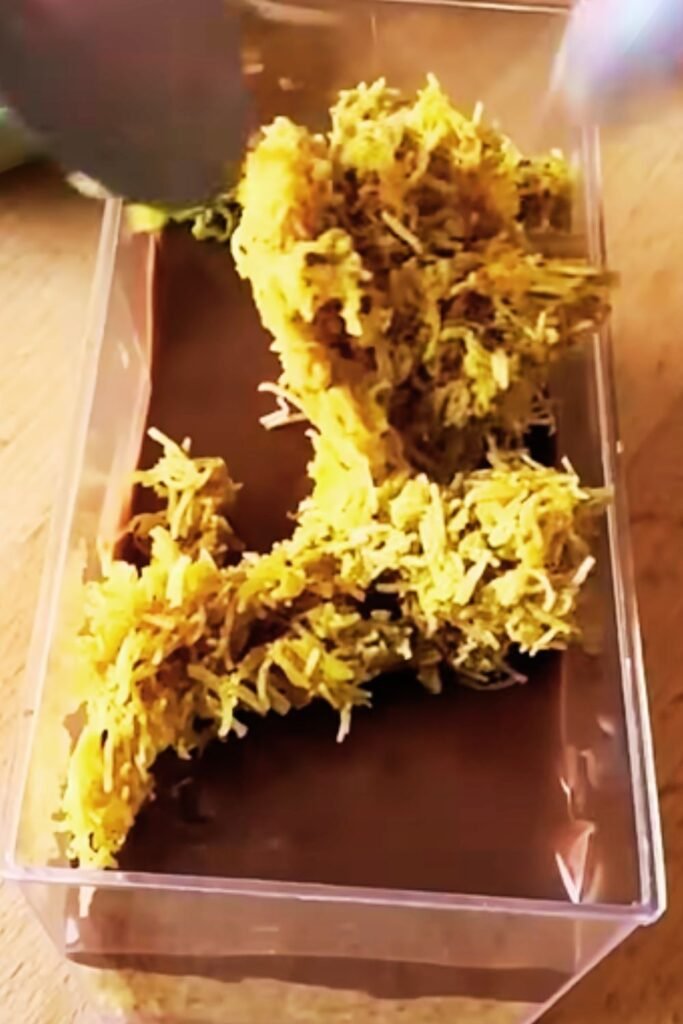The viral Dubai chocolate sensation has taken the world by storm, and I’m absolutely thrilled to share my perfected recipe for creating that signature crunchy kataifi filling that makes these chocolate bars so irresistible. After countless experiments in my kitchen, I’ve discovered the secrets to achieving that perfect balance of crispy texture, rich flavor, and luxurious mouthfeel that defines authentic Dubai chocolate.
When I first encountered Dubai chocolate, I was immediately captivated by its unique texture profile. The combination of smooth chocolate with the unexpected crunch of kataifi pastry creates an extraordinary sensory experience that’s unlike any conventional chocolate bar. This recipe will guide you through every step of creating this magical filling from scratch.
Understanding Kataifi Pastry
Kataifi pastry: Ultra-thin, shredded phyllo dough that resembles angel hair pasta or vermicelli noodles, traditionally used in Middle Eastern and Mediterranean desserts.
Tahini: A creamy paste made from ground sesame seeds, providing nutty richness and helping bind the kataifi mixture.
Pistachio butter: Luxurious spread made from ground pistachios, adding both flavor complexity and the characteristic green hue associated with premium Dubai chocolate.
The beauty of kataifi lies in its incredible versatility. When properly prepared, it transforms from delicate, hair-like strands into golden, crispy elements that provide the perfect textural contrast to smooth chocolate. I’ve found that the key to success lies in understanding how to manipulate this unique pastry.
Essential Ingredients and Quality Considerations
| Ingredient | Quantity | Quality Notes | Substitutions |
|---|---|---|---|
| Kataifi pastry | 200g | Fresh or frozen Antoniou brand preferred | Angel hair kadayif, shredded phyllo |
| Tahini | 3 tablespoons | Pure, unsweetened, well-stirred | Sunflower seed butter, almond butter |
| Pistachio butter | 2 tablespoons | Natural, unsalted preferred | Pistachio paste, ground pistachios |
| Butter | 2 tablespoons | Unsalted European-style | Ghee, coconut oil (refined) |
| Powdered sugar | 1 tablespoon | Fine confectioner’s sugar | Granulated sugar (processed fine) |
| Vanilla extract | 1/2 teaspoon | Pure vanilla, not imitation | Vanilla bean paste |
| Salt | Pinch | Fine sea salt | Table salt |
| Pistachios (chopped) | 2 tablespoons | Raw, unsalted, finely chopped | Almonds, hazelnuts |

When selecting your kataifi pastry, I cannot stress enough the importance of choosing high-quality product. Antoniou Fillo produces exceptional kataifi that maintains its structure beautifully during preparation. The strands should be intact, not broken into tiny pieces, and should have a slightly golden color rather than pure white.
Preparation Techniques and Methods
Step 1: Preparing the Kataifi Base
I begin by carefully separating the kataifi strands. This process requires patience – I gently pull apart the pastry with my fingers, creating individual strands that will crisp up beautifully during cooking. The goal is to achieve strands that are roughly 2-3 inches in length for optimal texture in the final product.
Step 2: Cooking Process
Heat your butter in a large, heavy-bottomed skillet over medium-low heat. The key here is temperature control – too high and the kataifi will burn before properly crisping; too low and it will become chewy rather than crunchy. I add the separated kataifi strands gradually, stirring constantly with a wooden spoon or heat-resistant spatula.
The transformation is remarkable to watch. The pale strands gradually turn golden brown, and you’ll hear a gentle sizzling sound as moisture evaporates. This process typically takes 8-10 minutes of constant stirring. I know the kataifi is ready when it reaches a deep golden color and feels crispy when I test a small piece.
Step 3: Flavor Integration
Remove the skillet from heat and immediately add the tahini while the kataifi is still hot. The residual heat helps incorporate the tahini smoothly throughout the mixture. I stir vigorously to ensure even distribution, creating a cohesive mixture that holds together without becoming clumpy.
Next, I incorporate the pistachio butter, powdered sugar, vanilla extract, and salt. Each addition requires thorough mixing to achieve uniform flavor distribution. The mixture should have a slightly sticky consistency that holds together when pressed but isn’t overly wet.

Texture Optimization Techniques
Achieving Perfect Crunchiness
| Technique | Purpose | Result |
|---|---|---|
| Constant stirring | Prevents burning, ensures even browning | Uniform golden color |
| Medium-low heat | Allows gradual moisture evaporation | Crispy, not burnt texture |
| Immediate tahini addition | Uses residual heat for smooth integration | Cohesive mixture |
| Cooling completely | Allows final crisping | Maintains crunch in chocolate |
The secret to maintaining that incredible crunch lies in proper moisture management. I’ve learned that any residual moisture in the kataifi will compromise the final texture, so I ensure complete cooking before adding wet ingredients. Additionally, I allow the mixture to cool completely before incorporating it into chocolate, as this final cooling period allows any remaining moisture to evaporate.
Storage and Handling
Once prepared, I store my kataifi filling in an airtight container at room temperature. Properly made filling retains its crunch for up to one week, though I rarely keep it that long because it’s so delicious! For longer storage, I refrigerate the mixture for up to two weeks, bringing it to room temperature before use.
Incorporation into Chocolate Bars
Tempering Considerations
When working with chocolate, I maintain my kataifi filling at room temperature to prevent temperature shock that could cause chocolate to seize or develop bloom. I gently fold the filling into tempered chocolate just before molding, ensuring minimal mixing to preserve the delicate crispy texture.
Ratio Guidelines
| Chocolate Type | Kataifi Filling Ratio | Texture Result |
|---|---|---|
| Dark chocolate (70%) | 1:3 (filling:chocolate) | Balanced, sophisticated |
| Milk chocolate | 1:4 (filling:chocolate) | Creamy, approachable |
| White chocolate | 1:3.5 (filling:chocolate) | Sweet, luxurious |
I’ve found these ratios provide optimal balance between the rich chocolate flavor and the textural interest of the kataifi filling. Too much filling overwhelms the chocolate; too little fails to provide that signature crunch that makes Dubai chocolate so special.
Flavor Variations and Customizations
Nut Alternatives
While pistachio is traditional, I’ve experimented with various nut butters and found several delicious alternatives:
- Almond butter: Creates a milder, sweeter flavor profile
- Hazelnut butter: Adds rich, chocolatey notes that complement dark chocolate beautifully
- Cashew butter: Provides creamy texture with subtle sweetness
- Mixed nut butter: Combines multiple nuts for complex flavor development
Spice Enhancements
For those seeking adventure, I recommend these spice additions (use sparingly):
- Cardamom: Quarter teaspoon ground cardamom adds exotic warmth
- Rose water: Few drops create floral elegance
- Orange zest: Finely grated zest brightens the overall flavor
- Cinnamon: Tiny pinch adds warm complexity

Troubleshooting Common Issues
Texture Problems
Soggy kataifi: Usually results from insufficient cooking time or excessive moisture in ingredients. I remedy this by returning the mixture to low heat and stirring until completely crispy.
Burnt flavor: Indicates too-high cooking temperature. Unfortunately, this cannot be fixed, so I start over with better temperature control.
Clumpy texture: Often caused by adding tahini to overly hot kataifi or insufficient stirring. I break up clumps by hand and stir more thoroughly.
Integration Challenges
Filling sinks in chocolate: Suggests chocolate was too warm when filling was added. I ensure chocolate is properly tempered and slightly cooled before incorporation.
Uneven distribution: Results from inadequate folding technique. I use gentle, figure-eight motions to distribute filling evenly without breaking delicate strands.
Nutritional Considerations
| Component | Per Serving (30g) | Health Benefits |
|---|---|---|
| Calories | 145 | Energy from healthy fats |
| Protein | 4g | From tahini and pistachios |
| Healthy fats | 12g | Monounsaturated from nuts |
| Fiber | 2g | From whole ingredients |
| Minerals | Varied | Magnesium, phosphorus, copper |
The tahini and pistachio components provide significant nutritional value, including healthy fats, plant protein, and essential minerals. While this is certainly an indulgent treat, the inclusion of these wholesome ingredients adds nutritional density compared to conventional chocolate fillings.
Serving and Presentation
Temperature Considerations
I serve Dubai chocolate bars at room temperature for optimal texture experience. Cold chocolate masks flavors and makes the kataifi less crispy, while warm chocolate can make the filling soggy. Room temperature allows both components to shine.
Portion Recommendations
Given the rich, intense flavor profile, I recommend smaller portions than typical chocolate bars. A 1-2 ounce serving provides full satisfaction without overwhelming the palate. The complex textures and flavors create a more satisfying experience than simple chocolate.
Pairing Suggestions
- Turkish coffee: The robust, slightly bitter coffee complements the sweet, nutty filling
- Mint tea: Refreshing contrast to rich chocolate
- Fresh berries: Natural acidity cuts through richness
- Sparkling water with lemon: Cleanses palate between bites
Advanced Techniques for Professionals
Scaling for Production
When preparing larger quantities, I maintain the same ratios but work in smaller batches to ensure even cooking. Large batches risk uneven browning and texture inconsistencies. I also use multiple skillets simultaneously rather than one large pan for better control.
Quality Control Standards
For consistent results, I maintain detailed notes about cooking times, color development, and final texture. Environmental factors like humidity can affect cooking times, so I adjust accordingly. I test small samples throughout the process to ensure optimal results.
Storage for Commercial Use
Professional applications require extended storage capabilities. I package cooled filling in vacuum-sealed bags with desiccant packets to maintain crispness for up to one month when properly stored in climate-controlled conditions.
Seasonal Adaptations
Summer Modifications
High humidity can affect kataifi crispness, so I extend cooking time slightly and ensure complete cooling before storage. I also reduce tahini quantity marginally to compensate for increased ambient moisture.
Winter Enhancements
Cold weather allows for longer storage times and easier chocolate work. I sometimes add warming spices like cardamom or cinnamon to complement the season.
Cultural Context and Authenticity
Understanding the cultural significance of Dubai chocolate enhances appreciation for this recipe. The combination of Middle Eastern ingredients (tahini, pistachios, kataifi) with European chocolate-making techniques represents the cosmopolitan nature of Dubai itself. This fusion creates something entirely new while respecting traditional flavors.
I’ve had the privilege of tasting authentic Dubai chocolate from various sources, and I can confidently say that mastering the kataifi filling is the key to recreating that distinctive experience at home. The filling provides not just texture contrast but also carries the essential flavor profile that defines this unique confection.
Questions and Answers
Q: Can I make this filling ahead of time? Yes, I regularly prepare the filling up to a week in advance. Store it in an airtight container at room temperature, and it maintains its crunch beautifully. For longer storage, refrigerate for up to two weeks.
Q: What if I can’t find kataifi pastry? While kataifi is ideal, I’ve successfully used shredded phyllo dough as a substitute. Angel hair kadayif also works well. The key is achieving those thin, crispy strands that provide the signature texture.
Q: Why does my filling lose its crunch in the chocolate? This usually indicates moisture issues. Ensure your kataifi is completely crispy before adding wet ingredients, and allow the mixture to cool completely before incorporating into chocolate. Also, check that your chocolate is properly tempered.
Q: Can I use different nut butters instead of pistachio? Absolutely! I’ve experimented with almond, hazelnut, and cashew butters with excellent results. Each creates a slightly different flavor profile while maintaining the essential texture and richness.
Q: How do I know when the kataifi is properly cooked? Look for a deep golden brown color and listen for the sizzling to diminish as moisture evaporates. I test a small piece – it should be crispy and make a slight crunching sound when bitten.
Q: What’s the best chocolate to use with this filling? I prefer high-quality dark chocolate with 60-70% cocoa content, as it provides nice contrast to the sweet, nutty filling. However, milk chocolate works beautifully for those who prefer milder flavors.
Q: Can I add more pistachios for extra crunch? Yes, I often add finely chopped pistachios for additional texture and flavor. Just be careful not to add too many, as they can make the mixture difficult to incorporate into chocolate smoothly.
Q: Is it necessary to use Antoniou brand kataifi? While not absolutely necessary, I’ve found Antoniou produces consistently high-quality kataifi that handles well during cooking. Other brands work, but may require slight adjustments in cooking time or technique.
Q: How do I prevent the tahini from clumping? Add the tahini while the kataifi is still warm from cooking – the residual heat helps it incorporate smoothly. Also, ensure your tahini is well-stirred before use, as natural separation is normal.
Q: Can I freeze the prepared filling? I don’t recommend freezing, as it can compromise the crispy texture. The filling keeps well at room temperature or refrigerated, so freezing isn’t necessary for storage purposes.
This kataifi Dubai chocolate filling has become one of my most requested recipes, and I hope you find as much joy in making and sharing it as I do. The combination of techniques, quality ingredients, and careful attention to detail creates something truly special that brings the magic of Dubai chocolate into your own kitchen.